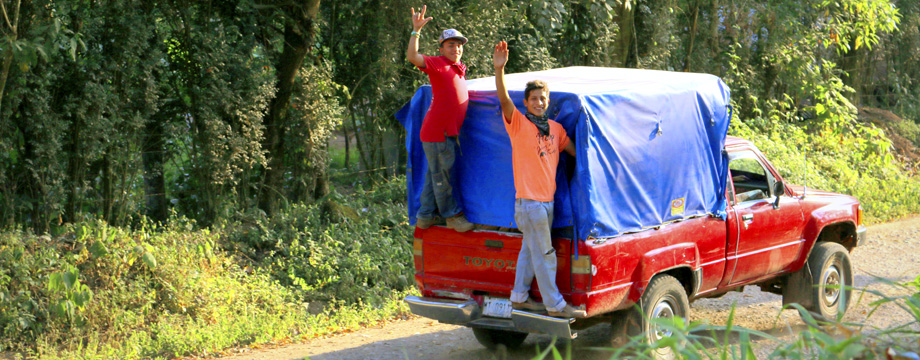The Nicaraguan Lifestyle
Nicaragua
While Nicaragua is the largest country in Central America, it is small enough that one can experience Nicaraguan life from coast to coast in a few days. Nicaragua is the beauty of the northern mountains, the immensity of the lakes and rivers, the majesty of the volcanoes; it is the taste and smell of coffee, a shy smile, a friendly hello; it is the color of the fruits and vegetables in the market, the women selling grilled meat or washing clothes in the river, the man selling newspapers, the simplicity of everyday life. These things and much more make Nicaragua a land rich in culture, history, and natural resources.
The uniqueness of the people, their sincerity and hospitality to foreigners, and the simplicity of their lifestyle seduce the hearts of visitors every year; they take with them an unforgettable experience of learning and sharing, of human contact, and of culture and wildlife.
Economy
Nicaragua is principally an agricultural country. The majority of the population lives off the land, with the main export crops being coffee, sugar cane, cocoa, bananas, cotton, sesame seed, and peanuts. Nicaragua also produces staple foods for national consumption such as beans, rice, and a variety of fruits and vegetables. Many Nicaraguans work in what is referred to as the “informal economy”: small-scale retail of products in bus stations, in the street, in their homes, or in markets. Thanks to changes in land possession and the work of many organizations, cooperatives have formed that promote collaborative labor and work toward fair trade, organic agriculture, and tourism.
Cultural expression
Nicaragua has a great variety of artistic expression. A diverse heritage of different races and cultures is reflected in the food, dances, music, customs, and traditions of the country. The traditional religious and national holidays and celebrations represent the essence of popular Nicaraguan culture.
Though there are folklore dances that characterize each region of Nicaragua, perhaps the most culturally representative Nicaraguan dance is the Güegüense, which interprets Nicaragua’s mestizo history and culture. Other musical expressions are the Nicaraguan “son,” the northern polkas and mazurkas, and the dances and “sones” of the Atlantic Coast. The Atlantic Coast is the most ethnically diverse region of Nicaragua, where each group conserves their own language, food, dances, and religious beliefs.
Traditional artisan crafts are also varied and have different characteristics in each region, based on their history and local materials. Some examples are woven materials, pottery made of clay, mud, rock, and wood, all of which are used for decoration or kitchen utensils. .
The people
“Nicas” are happy people who love to celebrate for any occasion. They are friendly, hospitable, hardworking, and open. The friendliness of Nicaraguans is one of the most outstanding traits of the Nicaraguan personality; they are always willing to help and show kindness. Nicaraguans are very social, and thanks to the simplicity of their lifestyle, they are always willing to take time to sit and chat and share a moment with others. Physical contact is very common - shaking hands, a kiss on the cheek, a pat on the shoulder – these are socially acceptable forms of communication.
Natural Resources
Nicaragua is a rich and abundant country. It is divided into three geographical regions: the Pacific, the Center, and the Caribbean; each with its own geography, climate, and topography. The difference between these regions results in a great diversity of ecosystems which provide many important natural resources that are necessary for the welfare and subsistence of the inhabitants of this country.
Because of this diversity, one can find more than 6,000 species of flora in Nicaragua, including medicinal plants, fruits, ornamental plants, and trees for lumber. There are more than 20 species of endemic orchids and trees such as conifers, cedar, mahogany, oak and many other precious woods.
Nicaragua also claims the two largest freshwater lakes in the Central American isthmus: Lake Xolotlán and Lake Cocibolca, as well as a number of large rivers that feed the jungles and forests of the Central and Caribbean regions. Many of these rivers are navigable and are the main transit route for the surrounding towns. Nicaragua also has artificial reservoirs that are used to produce electricity.
The country has very fertile soil which is well suited for growing different crops such as coffee, cocoa, grains, sugar cane, fruits, and legumes.
The Pacific volcanic range provides a number of natural resources such as hot springs, wildlife, and different ecosystems such as savannas and mangroves, among others.
The conservation and preservation of natural resources in Nicaragua is a priority: 16.94% of Nicaraguan territory is considered to be protected areas for the conservation of flora and fauna. Eleven of these protected areas are found in the department of Matagalpa and many of them are frequented by visitors looking for a chance to experience nature.
Wildlife
Nicaragua has great biodiversity due to its inter-tropical position and its location on the American continent, which makes is a transition zone between North and South America. Sixty-eight ecosystems have been identified in Nicaragua, in which there are more than 12,000 species of animals, including 700 species of birds, more than 200 species of mammals, and the rest being divided among reptiles, amphibians, fish, insects, mollusks, and arachnids.
Nicaragua also claims more than 100 endemic species, including mammals like the Segovian gopher (Orthogeomys matagalpae) found in the northern Central region and the Rama Squirrel (Sciurus richmondi) which is found in the southern Caribbean region.

